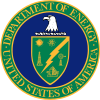Spallation Neutron Source
 | |
| A DOE Office of Science User Facility | |
|---|---|
| Location: | Oak Ridge National Laboratory, Oak Ridge, Tennessee, United States |
| Scientific Purpose: | Provide unique information about the structure and properties of materials across the spectrum of biology, chemistry, physics, and engineering. |
| Organization: | SNS is part of the ORNL Neutron Sciences Directorate, which also includes the High Flux Isotope Reactor, a steady-state neutron source. |
| Web site: | neutrons.ornl.gov |
| Science with neutrons |
|---|
 |
| Foundations |
| Neutron scattering |
| Other applications |
|
| Infrastructure |
|
| Neutron facilities |
The Spallation Neutron Source (SNS) is an accelerator-based neutron source facility that provides the most intense pulsed neutron beams in the world for scientific research and industrial development.[1] Each year, this facility hosts hundreds of researchers from universities, national laboratories, and industry, who conduct basic and applied research and technology development using neutrons. SNS is part of Oak Ridge National Laboratory, which is managed by UT-Battelle for the United States Department of Energy (DOE). SNS is a DOE Office of Science user facility,[2] and it is open to scientists and researchers from all over the world.

Neutron scattering research
Neutron scattering allows scientists to count scattered neutrons, measure their energies and the angles at which they scatter, and map their final positions. This information can reveal the molecular and magnetic structure and behavior of materials, such as high-temperature superconductors, polymers, metals, and biological samples. In addition to studies focused on fundamental physics, neutron scattering research has applications in structural biology and biotechnology, magnetism and superconductivity, chemical and engineering materials, nanotechnology, complex fluids, and others.
How SNS works

The spallation process at SNS begins with negatively charged hydrogen ions that are produced by an ion source. Each ion consists of a proton orbited by two electrons. The ions are injected into a linear particle accelerator, or linac, which accelerates them to very high energies (eventually to 90% the speed of light).[citation needed] The ions pass through a foil, which strips off each ion's two electrons, converting it to a proton. The protons pass into a ring-shaped structure, a proton accumulator ring, where they spin around at very high speeds and accumulate in “bunches.” Each bunch of protons is released from the ring as a pulse, at a rate of 60 times per second (60 hertz). The high-energy proton pulses strike a target of liquid mercury, where spallation occurs. The spalled neutrons are then slowed down in a moderator and guided through beam lines to areas containing special instruments where they are used in a wide variety of experiments.[3]
History
Most of the world's neutron sources were built decades ago, and although the uses and demand for neutrons have increased throughout the years, few new sources have been built. To fill that need for a new, improved neutron source, the DOE Office of Basic Energy Sciences funded the construction of SNS, which would provide the most intense pulsed neutron beams in the world for scientific research and industrial development.
The construction of SNS was a partnership of six DOE national laboratories: Argonne, Brookhaven, Lawrence Berkeley, Los Alamos, Oak Ridge, and Jefferson. This collaboration was one of the largest of its kind in U.S. scientific history and was used to bring together the best minds and experience from many different fields.
After more than five years of construction and a cost of $1.4 billion, SNS was completed in April 2006. The first three instruments began commissioning and were available to the scientific community in August 2007. As of 2011, a total of 15 instruments have been completed, and SNS is hosting about 700 researchers per year.
See also
- Linear particle accelerator
- Materials science
- Neutron
- Neutron detection
- Neutron electric dipole moment
- Neutron facilities
- Neutron scattering
- Spallation
References
- ^ In 2007, SNS was entered into the Guinness Book of World Records as the most powerful pulsed spallation source.
- ^ User Facilities | U.S. DOE Office of Science (SC)
- ^ "How the Spallation Neutron Source Works," ORNL Neutron Sciences web site.
External links
- Official website

- T. E. Mason et al., "The Spallation Neutron Source: A Powerful Tool for Materials Research," arXiv:physics/0007068v1.
- "SNS: Neutrons for 'molecular movies,'" Symmetry, vol. 03(05), Jun/Jul, 2006.
- Types of magnets
- Materials science
- Nuclear physics
- Particle physics facilities
- United States Department of Energy
- Oak Ridge National Laboratory
- Scattering
- Superconductivity
- Neutron facilities
- Buildings and structures in Anderson County, Tennessee
- Buildings and structures in Roane County, Tennessee
- Oak Ridge, Tennessee
- Neutron sources

